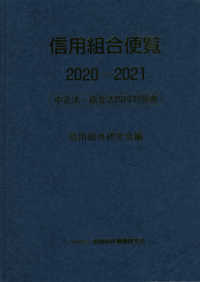Full Description
This book analyzes current security challenges in Asia (understood in its broader Indo-Pacific sense) with the aim of capturing the major shifts in the balance of power involving regional actors. Through the lenses of IR theory, this book seeks to provide insights into the consequences of the transition of power from the United States to China. The growing power of China and its impact on both neighboring countries and the international system as a whole, as well as its reception by the United States, have been of key importance to the development of security and international studies. By presenting the case studies of regional security challenges from a multidimensional perspective, this book analyzes both the stages of the maturity of powers and their satisfaction within the existing system.
Contents
Introduction
Olga Barbasiewicz, Marcin Grabowski, Ewa Trojnar
1 Changing Security Dynamics in the Indo-Pacific
Jakub Przetacznik
2 Asia-Pacific Security: Australia's Perspective
Attila Endre Simay
3 Foreign Trade as Economic (Inter)dependence in Asia
East Asian Problems
Paweł Behrendt
4 The Significance of Sea Lanes of Communication for Regional
Security in East Asia Andras Bartok
5 Amongst Dragons and Bears: Japan's Defense Policy during Heisei Era
Adam Stempler
6 The South China Sea Dispute between China and the Philippines
Krzysztof Kozłowski
7 Post-Cold War North Korea - People's Republic of China Relations
from a Game Theory Perspective
Zsolt Horvath
8 The Changing Picture of China: Can China's Investment in Soft
Power Change the World's Perception about the Asian Giant?
South Asian Security
Antonina Łuszczykiewicz
9 The China-India Border Conflict: Prospects for War and Peace in
the 21st Century
Adrian Brona
10 Development of the Belt and Road Initiative: Security Challenges
in South Asia
Ramachandra Byrappa
11 The Melting of South Asia's Frontier Zone and Its Consequences
Dora Gunsberger
12 CPEC through the Lenses of Security: Internal and External
Challenges
Notes on Contributors
Index








